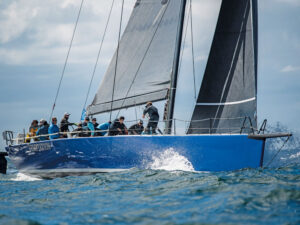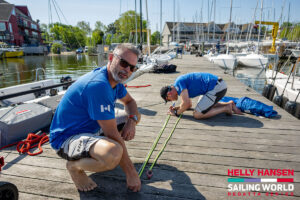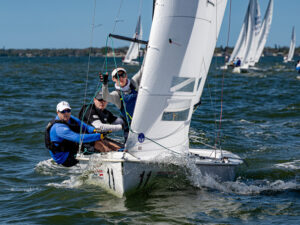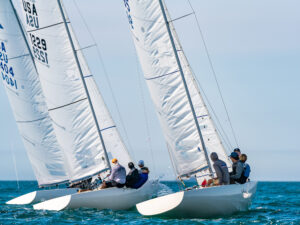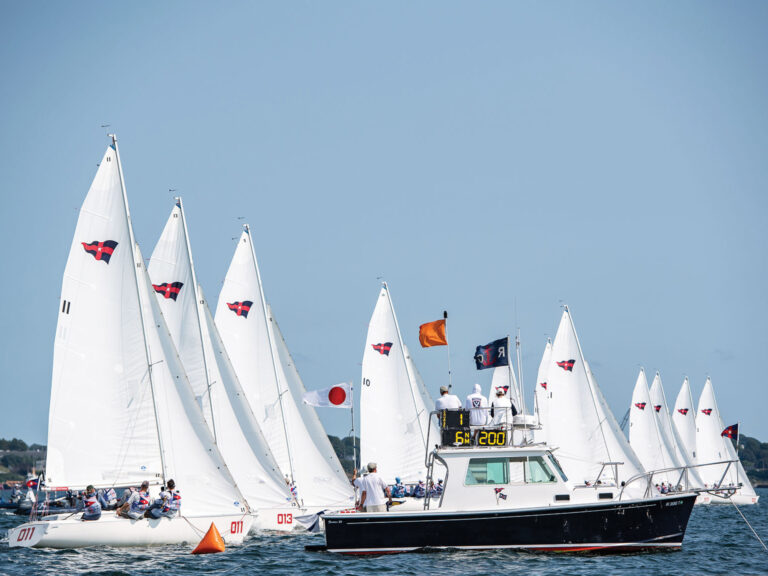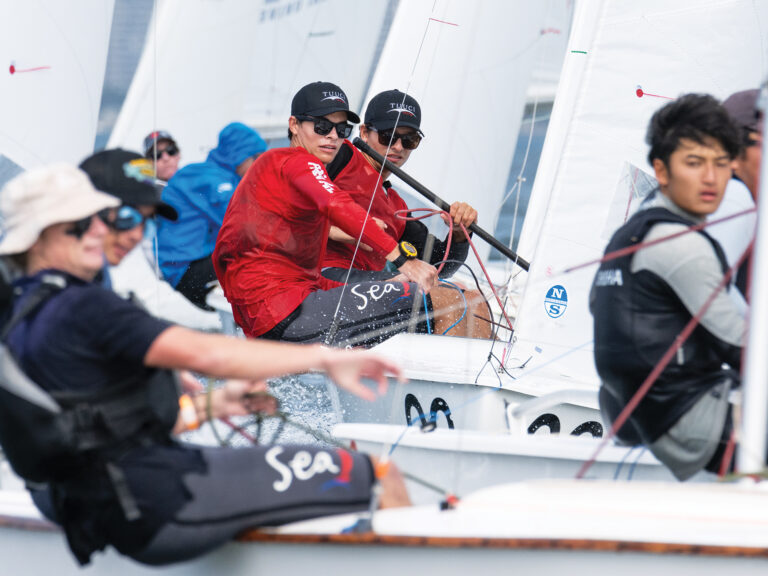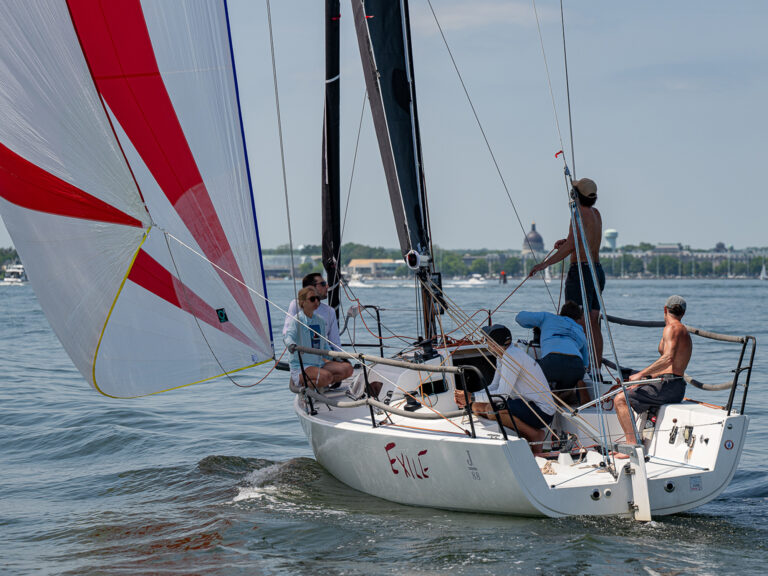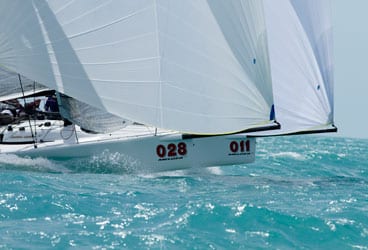
Melges 32 trim
Trimmer Scott “Chuck” Norris is quick to give credit where it’s due. He made his name in the Melges 32 class aboard Jeff Ecklund’s Star, with Harry Melges trimming the main, calling tactics, and liberally sharing his encyclopedic knowledge of sailing a planing boat. Norris was hardly a greenhorn, however, having won the 2003 Etchells Worlds with Ken Read and the 2005 J/24 Worlds with Anthony Kotoun. He was, and still is, a sought-after Melges 24 crew. When Ecklund took a hiatus from Melges 32 sailing, Norris was snapped up by Jason Carroll’s Argo program. As we went to press, Norris, Carroll, and the rest of the Argo team, which won its second consecutive national championship off Newport, R.I., in July, were prepping for the 2012 Melges 32 Worlds on the same waters in late September.
When you transition from a displacement boat—whether it has a symmetric or asymmetric spinnaker—to a planing sport boat such as a Melges 32, what are the keys to trimming a spinnaker?
Planing sprit boats rely a lot on apparent wind. On a displacement boat, the wind is basically pushing you downwind, where on a boat with an asymmetric spinnaker, you actually have flow over the spinnaker, and the hotter or higher you sail, the more wind you create and the more loaded the boat gets. That speed generates apparent wind, which you can then use to sail a lower angle.
Higher is usually faster in a straight line, but the angle that generates the best velocity made good toward the leeward mark can be tougher to find. What are some of the cues you use to determine the correct angle for a particular wind condition?
We rely a lot on angle of heel, and how much weight we have on the rail. Right before we go downwind, I get a feel for the wind speed. I’m thinking, “How much weight do we need on the rail going downwind?” It’s all about nailing that angle right away after the windward mark. The most challenging thing in sport boats is the transition from displacement to planing. If you’re able to get planing before the other guys, you’re instantly going 15- to 20-percent faster.
In those marginal conditions, where you want to be planing in the gusts but soaking low in the lulls, what is the trimmer’s role?
I’ll make a couple of calls at the windward mark. In the lighter conditions, it’ll be either jib up or jib down. As it gets windier, we talk a lot about how much weight to move fore and aft, because as the boat loads up, the bow wants to dig in, so you’ve got to get the weight back. If the breeze is right around the crossover wind strength, it’ll be weight on the rail, hiking, rather than weight back. We call that the lazy plane mode. In addition to the weight and the angle, I’ll also call how much backstay to ease off, which has a pretty dramatic effect on the power downwind.
If you’re in planing mode and the wind lightens, how does the communication work to transition to soak mode?
A call from the rail will come that it’s going to get substantially lighter. A lot of times I’ll look over my shoulder to see what’s going on. And then if we feel like we’re trying to push the plane and it’s not working anymore, then we’ll call for a mode change. Any bodies in the back of the boat will come forward, and the boat will come down however many degrees.
During this time, how is your spinnaker trim changing?
When you’re planing, the spinnaker will be trimmed a little bit tighter. When you go into the displacement mode, weight comes in, the boat gets in a flatter mode, and the spinnaker requires a lot more ease, so that it projects out in front of the boat.
What are the sorts of things that you can do to help keep the boat on the plane, such as when you’re sailing through a brief lull, or simply milking the last bit of a puff?
I try to generate as much power as I can. If you have the spinnaker trimmed in and there’s no curl in the front of the spinnaker, then the wind over the spinnaker is stalling. And what you’re looking to do is maintain flow on it all the time. I try to sail with two to three inches of curl all the time.
Are there any cues that you’re losing flow?
It’s primarily a combination of the curl and the pressure that I feel on the sheet. When it’s lighter, and you’re going through waves and the boat starts bouncing, people have a tendency to pull the spinnaker in tighter, which is good to a point because you’re keeping the thing loaded, but it can also be bad, because you’re over-trimming it and losing flow. So when you get in the chop and the spinnaker starts to kind of pump a little bit, it’s a delicate balance between keeping the thing loaded, and keeping the thing eased enough so that you have flow.
One thing trimmers often talk about is matching the leech profiles of the main and the spinnaker. You don’t have the necessary perspective to see the profile from the boat. So how do you go about doing that?
For the most part, the spinnaker is what it is in terms of the leech profile. You can have a little bit of effect on it with the backstay; letting it forward will close off the leech on the kite, and pulling it back will open it up. You’re primarily talking about the main at that point, and sailing with a lot of vang off.
If we’re going to sail a little bit higher, we’re going to need a little more twist. So I’ll call for a little bit more backstay, and then the main trimmer will automatically go for a little more vang off. If we need to sail lower, the backstay will come off a little bit to tighten up the leech of the spinnaker, and then he’ll pull on the vang just a little bit to get a little more power.
I kind of gauge the backstay by how much slop there is in the headstay. If you have way too much backstay on when you go downwind, then the main will be inverted. In the really big wind, the backstay will come off a couple inches when we go around the windward mark, and once we get set and going then we’ll fine-tune everything.
Tell me a little bit about spinnaker sheet movement on the Melges 32. Some people seem to move the sheet quite a bit; some people seem a lot happier to just lock it in and let the boat move around.
It depends on how good your driver is, ultimately. Once you kind of get the sheet about where it needs to be, a good driver can steer to the luff of the spinnaker and it’s really quick. In terms of sheet movement, on the 32, the most sheet I ever go through is probably four feet. On the Argo, Jason’s a really good driver. So therefore, we need to be moving the sheet a lot less. With a less experienced driver, the bow is going to be moving around a lot more, so whoever’s trimming is going to need to play the sheet accordingly; keep the spinnaker trimmed properly with just a teeny bit of curl at times in the luff. The sheet moves a lot more in lighter air, because your bow is kind of moving a little bit more to the changes in velocity.
In light air, describe how the communication works between the trimmer and the helmsman.
When we’re going in a straight line, it’s a lot of: “Pressure’s good here, no lower than this; still good pressure; no lower than this … pressure’s increasing, you can sail a tick lower; good angle here, no lower.” If we get a puff, and the boat loads up: “Tons of pressure, no higher, you can take it lower … good angle here.” It’s constant communication, we’re probably talking every 10 seconds, or I am.
Is that the most effective relationship, where you’re constantly setting a lower boundary for the helmsman, and he’s constantly trying to squeeze down?
Absolutely. In sport boats, or any high-performance boat, it’s always going to feel better sailing higher, because you’re going to go faster, but it’s not necessarily your best VMG.
How do you set that lower limit?
I do it based on the load on the sheet, and the angle of heel of the boat. However, setting a boatspeed target is good for the driver so he knows when he’s approaching the point where he may get too low and the boatspeed will fall off the cliff.
In the big breeze, how does the communication loop change?
In the really windy stuff, we’ve got somebody calling the breeze the entire time, which is super important, because once you’re up and planing, you’re trying to keep your apparent wind going. So when I hear the call from the rail: “There’s a puff coming in 3 … 2 … 1” then we’re trying to time sailing a little bit lower as the puff hits. The key to that is the timing of the person calling the puff. You don’t want the boat to heel too much, but you want it to load a little bit, and then accelerate as you head down.
Do you generally ease the sheet a little when the velocity increases?
If the wind direction remains steady, you’re going to have to ease the spinnaker, because the apparent wind is moving a little bit farther back. Once the boat starts to accelerate, then you’re going to have to trim back in.
You mentioned the ‘jib up, jib down’ thing. What goes into that decision?
The jib is like a staysail in a bigger boat. It just generates a little bit more horsepower. The crossover is approximately eight knots of breeze. If the breeze is below that, the jib blocks the wind into the spinnaker and disrupts the flow between the spinnaker and the main.
When it’s up, how do you know when you’ve trimmed the jib properly?
You need to kind of keep it as eased as you can on the sheet. You need to keep it parallel to the wind that’s flowing through the slot. So if you over-trim it’s going to affect the spinnaker quite a bit, and it’s better to have it a little under-trimmed than over-trimmed.
Take us through a good set on the Melges 32.
It’s usually either our tactician or helmsman who makes the call for the hoist. More often it’s the helmsman, because in the really windy stuff he has have the bow down far enough that the chute doesn’t blow back into the rig or inflate as it’s going up. After we come around the offset mark and put the bow downwind; the helmsman will call the hoist. The mast guy starts pulling on the halyard, I’m watching the head kind of go up behind the main, and we’ve got a couple of big marks on the halyard that tell me when we’re getting close to full hoist. I try to time it so I’m going in on the sheet just as the head of the sail is getting to the top of the rig. Once that happens, I’m calling for the bow to go up so that we can accelerate and go. And during that whole circus of events, all the weight is going in the right spot, too. You don’t want to head up to your angle until you have the sheet pulled on and, if it’s really windy, you have the weight in the right spot.
Which brings us to the last question: wiping out. It’s going to happen to everyone in a boat like the Melges 32. Let’s look at preventing it first.
First of all, being on the edge of control is when you’re going the fastest. When it’s windy, if you’re pushing hard, you’re on the hairy edge a lot. In those conditions, the vang will be most or all the way off, so that the main’s really twisted up high. Some backstay on will flatten out the front of the spinnaker and twist it off in the back to help depower a little bit, and you’ll be easing the sheet. The most common time for a wipeout is when you hit the back of a wave, the boat slows down, and your apparent wind goes back. Watching the waves and anticipating when the bow isn’t going to come up and get over the wave is key. If you see that you’re going to plug into the wave, you can kind of preempt it by easing a little bit earlier, to compensate for the apparent wind moving aft. If you hit the back of the wave, and the chute doesn’t get eased, then you’re going to go over. Downwind, in breeze, I’m watching the waves the whole time.
If you do wipeout, how do you get it back up?
It depends. First, the mainsheet should be out all the way and the vang off all the way. Those have usually already happened, but just in case, make sure they’re both loose. Get everybody up on the windward side hiking, trim the jib normally, so that you have flow going over the jib, and with enough weight on the rail, the boat should come back down.
Once the boat goes flat, and you feel like your angle is far enough away from the wind, you can trim the spinnaker back on. The angle from where you trim out of a wipeout is similar to where you would be for a set.
If that doesn’t work?
Then you’ve got to drop the chute 30 percent of the way, with people still on the rail. Once the boat starts righting itself, the mast guy and the pit guy need to start going on the halyards so the chute doesn’t end up in the water.

